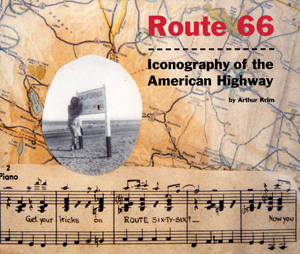|
||
      |
Peer Review ::
Open Book
Route 66: Iconography of the American Highway (Center for American Places, 2006) by Arthur Krim, AM’67

It’s a road, says historian Arthur Krim of the famous Chicago-to-Los Angeles stretch, “that had much more meaning than just a road.” Officially removed from the U.S. highway system in 1985 when it was replaced by a new interstate, Route 66 retains mythic status as a symbol of American enterprise and exploration. Portrayed in works such as Bobby Troup’s 1946 melody “(Get Your Kicks on) Route 66,” John Steinbeck’s Grapes of Wrath, and Jack Kerouac’s On the Road, the highway extended more than 2,400 miles, tempting drivers to brave the rugged landscape of old Western frontier trails and giving birth to a lasting cultural iconography. “Had Steinbeck not written Grapes of Wrath, Route 66 would not have been as popular,” says Krim. “It was a highway created off very intense moments of creative pressure.”
“Route 66 was the American highway of the twentieth century, straddling it from Jazz Age to Computer Age, in gravel and concrete, in song and film, in television and Pop Art. Projected as an idea in the euphoria of the California Gold Rush, Route 66 endures as an idea in the euphoria of the Internet; but, between 1926 and 1985, the idea was a road, U.S. 66, a fact on the ground that did much to make one nation out of the United States. As the road was traveled, its meaning changed: initially the resolution of an ancient dream of a direct route to the Pacific, Route 66 became an incarnation of Walt Whitman’s democratic ideal of the Open Road.”